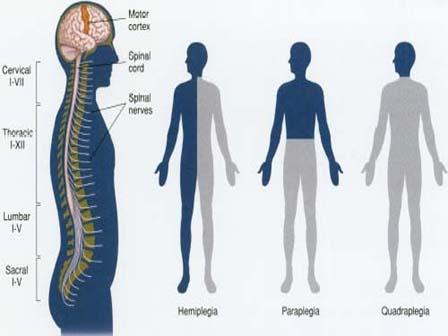
The human brain, awesome in its intricacy and power, is still largely a mystery to modern science. With more than 10 million nerve cells it is the home of all that we know and feel, the generator of every physical action and response. Yet, unlike other cells in the body, brain cells once damaged are not good at repairing themselves. And they can be damaged quite easily – by infection, injury, or oxygen starvation. Should any part of the brain go without oxygenated blood for more than a few minutes the affected cells will pack up permanently – the body has suffered a stroke.
Definition
Hemiplegia is paralysis of either the right or left side of the body, while paraplegia is paralysis of both the lower limbs (legs). Paralysis is also associated with loss of control over urination and defecation.
Causes
Pathological (abnormal) changes in the brain – either a blood clot or bleeding through any of the blood vessels in the brain.
In Ayurveda, improper diet and conduct (which disrupt Vata Dosha), are included in the causative factors of paralysis.
High blood pressure.
Symptoms
Sudden loss of control over either side of the body, with limpness in the arm and leg regions of the affected side.
Associated with severe giddiness or unconsciousness and a fall and external injury.
Slurred speech, loss of control over urination and defecation, constant dribbling of saliva from the mouth.
Inability to move arms and legs or complete inability to move.
Signs
The signs of a stroke vary a great deal, depending on which part of the brain has been damaged, but symptoms range from a sudden loss of speech or movement to dizziness, blurred vision, confusion, and unconsciousness. They may last only a few hours: this is called a transient ischemic attack (T.I.A.). If the symptoms don’t disappear, this is a full-scale stroke.
There are various ways that the flow of blood to the brain can be slowed or stopped. Sometimes a clot (thrombosis) forms, blocking the flow of oxygenated blood. Or a blood clot (embolism) which formed somewhere else in the body breaks free and ends up blocking an artery to the brain. In other cases, blood bursts through the wall of a weak artery into the brain (haemorrhage), eventually building into a clot.
The good health our arteries is crucial I avoiding strokes. Anything that makes them fur up or harden – such as smoking or high levels of cholesterol (caused by eating animal fat, lack of exercise and stress) can make a stroke more likely. These are not risks to be taken lightly: a third of first strokes are fatal.
Luckily, our brain cells have so many connections between them that healthy cells can often take over the function of damaged cells so that we hardly know that anything has gone wrong. Half of stroke survivors return to full health, but much depends on how much damage has been done to the brain, as well as on the aftercare provided.
Treatment may include :
Acute cases require emergency ICCU care and intensive treatment.
In chronic cases, maintenance and regular check up of blood pressure is mandatory.
To relieve weakness in arms and legs, massaging regularly with medicated oils.
Hot fomentation all over the body: Allow the patient to sit in a bathtub, filled with hot decoction of Pluchea lanceolata (Rasna) or Dashamoola (roots of ten herbs), immediately after massaging the affected arm with any oil.
Take a Dashamoola decoction in a 30-ml dosage, thrice, daily.
Alternately, a decoction of the bark and roots of the Deodar tree in a 30 ml dosage, thrice, daily.
A decoction of the roots of Castor plant with ginger, in a 30-ml dosage, thrice, daily.
Tablets made with three myrobalans (Triphala), long pepper and gum guggul (Comiphora mukul) in a 1-gm dosage, thrice, daily.
Tablets made of gum guggul (Comiphora mukul) and tinospora (Guduchi) in a 1-gm dosage, thrice, daily.
A decoction of Pluchea lanceolata (Rasna) in a 30-ml.
MARMA MASSAGE
Ayurvedic physicians have used the knowledge of vital points in treating injuries for thousands of years. The practitioner in question sees stroke damage as lack of co-ordination between body and mind. Marma therapy for a stroke normally consists of 24 half-hour sessions once or twice a week, together with intensive exercises to practice at home. “Marma therapy can clear away obstructions between muscles, nerves and the brain”, explains the practitioner, “so that the brain can relearn how to control and co-ordinate the body, helping you to get back to a normal life”.
AYURVEDA
In this ancient Indian system of health care, the body’s active energies need to be balanced and maintained in order to stay well. Powerful oils and herbal medicines may be used to treat people who have had strokes. Treatment concentrating on the Vata dosha, which controls the nervous system, can correct obstructions to the nerve pathways, believes one Ayurvedic practitioner. “Panchakarma (revitalizing) methods are highly successful and should be given regularly”. He also prescribes exercises, according to the condition of the individual. A course of treatment can take months or even years, with consultations once a month.
Do’s & Don’t
Stick to fresh, warm meals.
Take hot soups made with either lentils, pulses or meat and a dash of powdered ginger, black pepper and long pepper.
Avoid spicy, deeply fried, oily and pungent foods as these can cause damage to the degenerated nerves and weakened limbs and joints.
Include ghee and oils in a moderate quantity in meals, as these subdue the vitiated Vata Dosha and also `lubricate’ the ‘wasted’ muscles.
